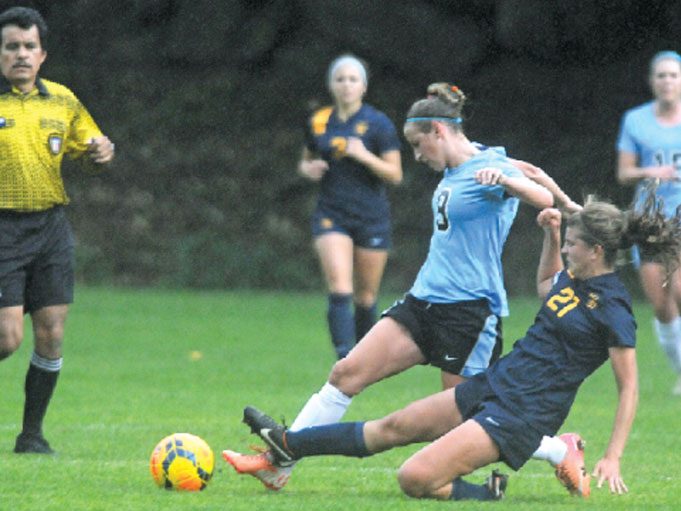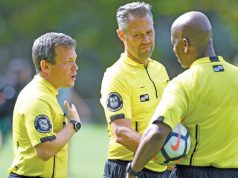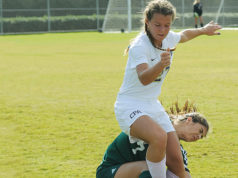“I got ball, ref!” has been a response to a whistle for a slide tackle foul since the early days of football. Often misunderstood, challenges on the ground require the referee to read the game and the players to properly manage a match. For the purposes of this article, we’ll define ground challenges as a tackle or slide tackle against a ballhandler.
Until removed from FIFA Laws in 2008/2009, the wording, “tackles an opponent to gain possession of the ball, making contact with the opponent before touching the ball,” as a direct free kick foul, caused confusion on the application of the law. Was incidental contact included? Did trifling and doubtful contact count? How about the contact initiated by the attacker at the completion of the tackle?
The International Football Association changed Law 12 to simply read, “tackles an opponent” in a manner that is careless, reckless or using excessive force, leaving the determination to the referee. They added sanctions as serious foul play for excessively dangerous tackles. Nothing in the laws provides sanctions for challenges on the ground.
Determining if a foul occurs requires the referee to be observant before, during and after the tackle. Judging the challenge must include: the defender’s proximity to the play, the attempt to play the ball, the ability to play the ball, force used in the challenge and any ulterior motive or malicious intent of the defender.
Before the tackle, the proximity to play and any ulterior motives must be assessed. Was the defender executing the slide tackle coming from a great distance to tackle the ball or is the attacking player the tackler’s objective? The direction of the tackle from the front, side or rear also needs to be observed. Tackles from the rear and some from the side are blind to the ballhandler, resulting in a different reaction by that player. Slide tackles from the front and some from the side are in the view of the ballhandler, and that player may be able to avoid contact or evade the tackle.
During the ground challenge, assessing the ability of the defender to play the ball, force used and the reaction of the ballhandler are important to the referee. Contact with the ball is irrelevant to the referee’s judgment on this potential foul or misconduct. Contacting ball or not is unimportant; rather, the result of the tackle and contact with the ballhandler is the primary factor in the determination. Simple actions such as “cleats up” or clearly contacting the legs of the attacker with the lead or both legs are easy in determining that a foul has occurred. Difficulty in making the judgment is the result of contact by the back leg of the tackler on the ballhandler after the front leg leads a fair challenge. Some of the contact may be incidental, trifling or may have no impact on the ballhandler’s ability to continue to remain in control. Generally, the higher the contact on the ballhandler’s legs the more likely a foul and some degree of misconduct occurred. Frequently, referees will see an attacker fail to lift their legs or step over the defending tackler and fall. In that situation, the referee must judge if the attacking player could have and should have avoided the contact. If not avoidable, no foul.
Slide tackles from the rear offer additional assessments by the referee. Frequently, the attacker will fall with less contact by the tackler. The referee must determine if the tackler’s actions reached the level of “careless, reckless or with excessive force.” The mere fact that the tackle was from the rear does not constitute a foul. Tackles from the rear should be regarded with suspicion and draw close inspection.
Phase 1
After the initial challenge, the referee must determine if there was a fair challenge, then a foul or if two fouls were committed by the tackling player. The fair/foul scenario is the event that most often receives the “I got all ball, ref!” response. That may be true, but the action after the clean tackle must be sanctioned. Getting the ball does not eliminate the possibility of a foul. Clearing the ball with the front foot and taking out the Achilles tendon with the back leg is clearly a foul. Similarly if, after a clean tackling of the ball by a defender with a slide tackle, the attacker falls to the ground, there may or may not be a foul. The two-foul situation may be a careless tackle followed by a trip. Here, which foul is called is of little consequence since the resulting restart is the same, but which foul is recognized by the official can make an important difference to decisions about misconduct. The quicker the whistle, the less likely further problems will result.
Phase 2
After determining that a foul has been committed, the referee must assess if the actions elevate to reckless or excessive force. Misconduct often accompanies illegal ground challenges and must be judged based on several factors.
Before, during and after the sequence of a challenge on the ground with potential misconduct, the referee must be mindful of the players and the game situation. The possible malicious intent of the player executing the challenge is important. Past history in this (or other known) game, skill level and circumstances of the given situation are important to evaluating intent. Most frequently, slide tackles from the rear are a result of a defender being beaten by the attacker. That immediately makes the defender more aggressive. Ground challenges from the side or front are often the result of defense in depth where the first defender has failed to stop the attack or through balls to an unmarked attacker. That will result in challenges and tackles initiated a greater distance from the attacking play. Those challenges are frequently done with greater speed and less control by the tackling player. Results of the challenge and injury to the attacking player must be considered by the referee. Often those situations will result in potential serious injuries from the reckless play and excessive force. Boots cleats-up and hard contact with the Achilles area will almost always result in misconduct in addition to the foul. Referees must also be prepared to sanction dives when the attacking player falls to the ground to draw a foul after a fair challenge. Match score, distance from the goal and time during the match will also affect the speed, force and tackler intent during those situations.
Referees must judge the challenge on the ground without the emotion of the “I got all ball” mentality and the reaction of both players and spectators. The factors covered provide the referee with guidelines to make the right call at the right time, keeping the game fun, fair and safe.
What's Your Call? Leave a Comment:
Note: This article is archival in nature. Rules, interpretations, mechanics, philosophies and other information may or may not be correct for the current year.
This article is the copyright of ©Referee Enterprises, Inc., and may not be republished in whole or in part online, in print or in any capacity without expressed written permission from Referee. The article is made available for educational use by individuals.


















